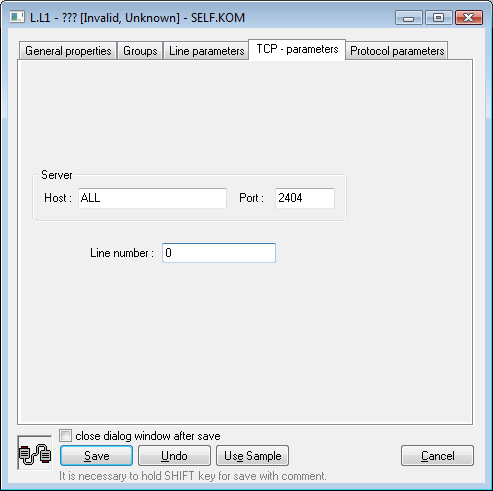Configuration of communication lines of TCP/IP-TCP and TCP/IP-TCP Redundant categories.
Lines of categories TCP/IP-TCP and TCP/IP-TCP Redundant were designed for the needs of communication protocols that are built directly on TCP/IP. Both IPv4 and IPv6 protocols are supported. TCP/IP-TCP Redundant enables the implementation of redundant communication (redundant network lines, redundant network interfaces) and configuration of two or more IP addresses of a communication partner, and creation of two parallel TCP connections.
The following protocols are supported at the present time:
Line TCP/IP-TCP
- Allen-Bradley CSP/PCC
- Datalogger ESC8816
- DLMS/COSEM
- DNP3
- Ethernet/IP
- General Electric SRTP
- Generic User Protocol
- HART
- IEC 60870-5-104
- IEC 60870-5-104 Server
- IEC 60870-5-104 Sinaut
- IEC 60870-6 ICCP/TASE.2
- IEC 61850
- IoT over LoRaWAN/Sigfox
- Johnson Controls N2-Bus
- KMZ Lite protocol
- KMZ protocol
- KNX protocol
- L&G TOCCATA
- MODBUS Client
- MODBUS Server
- MQTT Client (Message Queue Telemetry Transport)
- Omron FINS
- Orange GDEP
- SAE RTU
- Siemens SAPHIR
- Siemens SIMATIC S7 ISO on TCP
- Telegyr 809 Server
- Teltonika Codec14
Line TCP/IP-TCP Redundant
- DLMS/COSEM
- Generic User Protocol
- HART
- IEC 60870-5-104
- IEC 60870-5-104 Sinaut
- IEC 60870-6 ICCP/TASE.2
- MODBUS Client
- Siemens SAPHIR
- Siemens SIMATIC S7 ISO on TCP
TCP/IP-TCP line configuration
Server - Host
IP address or network name of a computer. If the name is configured (and not an IP address in the format X.X.X.X), it will be converted into an IP address using the standard name resolution mechanism provided by OS (hosts, DNS, WINS ..).
If a server protocol is configured, the IP address for the KOM process to listen should be configured, i.e. the IP address of one of the computer network interfaces on which the KOM process runs. Example: 127.0.0.1 or localhost (local interface), 192.16.0.1.
Note: It is possible to use symbolic addresses * or ALL (for IPv4 protocol) or [*] or [ALL] (for IPv6 protocol) - in this case, the KOM process listens on a chosen TCP port on all network interfaces which are available.
If the configured protocol is not a server protocol, the IP address of the communication partner to which the KOM process connects should be configured.
Note: If the configured protocol is not a server protocol, for selected protocols, multiple IP addresses or names can be configured (separated by commas or semicolons). The KOM process will cyclically try all configured IP addresses/names when connecting to a communication partner.
Server - Port
If a server protocol is configured, enter the TCP port number on which the KOM process should listen. Otherwise, enter the TCP port number of the communication partner to which the KOM process should connect.
Line number
It is used for the configuration of a specific parameter in selected protocols, in other protocols, it is not used and it can be set to any numeric value (e.g. 0).
TCP/IP-TCP Redundant line configuration
Primary Device - Host
Primary IP address of the communication partner to which the KOM process connects. If the name is configured (and not the IP address in the format X.X.X.X), it will be converted into an IP address using a standard name resolution mechanism provided by OS (hosts, DNS, WINS ..).
Primary Device - Port
A number of the primary TCP port of the communication partner to which the KOM process connects.
Use Backup Device
If this option is not selected, the KOM process does not connect to the backup IP address and the line works like a TCP/IP-TCP line, i.e. without redundancy.
Backup Device - Host
The secondary IP address of the communication partner to which the KOM process connects. If the name is configured (and not an IP address X.X.X.X), it will be converted into an IP address using the standard name resolution mechanism provided by OS (hosts, DNS, WINS ..).
Note: implementation of redundancy is protocol-dependent. For some of the protocols (e.g. IEC 870-5-104) a parallel connection to the backup device is created. For some protocols (e.g. Modbus Client), the KOM process creates a single connection, alternately (after the connection is broken or cannot be established) using all IP addresses/names configured as Primary/Backup Devices.
Backup Device - Port
The number of a backup TCP port of the communication partner to which the KOM process connects.
Note about entering the Host parameter
Parameter Host can contain several (up to 8) IP addresses or network names of computers separated by comma or semicolon, e.g. 172.16.0.1; 172.16.0.2 (spaces are permitted before and after the IP address due to readability). See the documentation of a used communication protocol to find out whether it can utilize more than one IP address. For example the protocol IEC 870-5-104: if several IP addresses are configured (on TCP/IP-TCP or TCP/IP-TCP Redundant lines), the connection is initially established to the first IP address. If the connection breaks, the KOM process tries to reconnect to the second IP address, then to the third, etc... After all configured IP addresses are tried, it uses again the first IP address.
This configuration can be used if several communication partners exist and they either provide the same valid data or only the one which is active, i.e. it communicates (and all others refuse the connections).
Other protocols (e.g. MODBUS Client) currently use only the first configured IP address.
Note about the redundancy of network communication
Currently, only two protocols supporting the TCP/IP-TCP redundant line are implemented. Protocol IEC 870-5-104 Sinaut is a specific implementation of the protocol IEC104 designed for redundant communication with the Sinaut Spectrum system. Much more frequently you can meet the protocol IEC 870-5-104, which has many options related to communication redundancy implemented.
Related pages:


0 komentárov